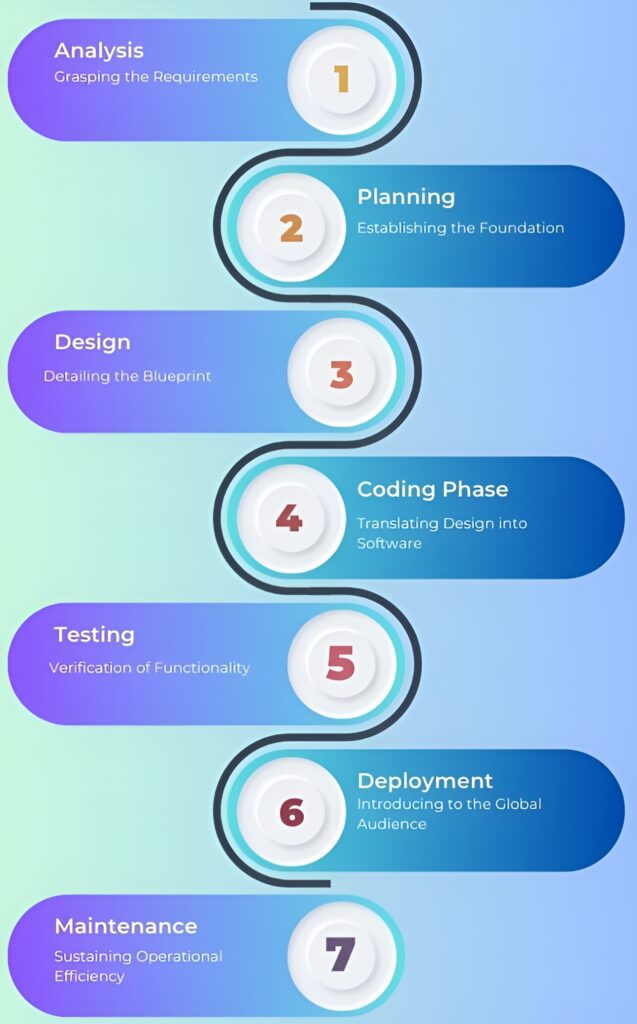Software development has become an integral tool for businesses in the modern era. Let’s explore how software development has helped businesses to provide the best experience to their, and delve into the processes involved in setting up a software development function within a company.
The Impact of Software Development
Software development is critical in modern business culture. It is transforming how organisations and individuals interact. The importance of crafting software’s rests in developing effective answers to complicated issues, which drives growth and rapid advancements across industries.
Software applications fuel everything from communication devices to essential infrastructure, increasing productivity and connectivity.

Software development has a major impact on the digital landscape and the global economy. It speeds up technical developments, streamlines operations, and encourages collaboration.
As society becomes more reliant on digital solutions, the importance of software development in moulding our future becomes clear, with far-reaching implications for how we work, communicate, and traverse the ever-changing digital environment
- Why is Software Development so Important for Customer Experience?
- Significance and Objectives of Software Development: 9 Essential Reasons
- Fulfilling Business Goals through Software Development
- As the significance of software development grows, vendors assume a new role
- The software development process consists of 7 fundamental Steps.
Why is Software Development so Important for Customer Experience?
In this age of digital transformation, the importance of software development for customer experience cannot be emphasised. As consumer expectations shift towards personalised, multichannel experiences and new solutions, organisations must adapt to remain competitive.
The influence of tech behemoths like Amazon and Netflix raises the bar, making it critical for businesses, regardless of industry, to provide equal service levels.

The scarcity of qualified developers in fields such as data science, AI/ML/NLP, and cybersecurity, along with strong demand and competitive wages, highlights the need of organisations investing in software development expertise. Strategic sourcing, which combines internal personnel, freelancers, and outsourced teams, has emerged as a viable solution for organisations dealing with the skills deficit.
The continuing epidemic has highlighted the essential importance of software in company survival. Companies that were unprepared for an all-digital marketplace during the initial shutdowns in 2020 suffered significant financial losses. The transition to remote work has increased the demand for software development, resulting in significant investments in digital solutions.
As a result, software development is no longer an option, but rather a “need” for a company’s survival. It is critical for adjusting to changing market conditions, providing a consistent customer experience, and staying ahead in an ever<li>-changing digital marketplace.
Understanding the Significance and Objectives of Software Development: 9 Essential Reasons
1. Enhanced Productivity
When a software development process is appropriately executed, it has the potential to reduce task completion times significantly, resulting in substantial time savings. The automation of specific tasks empowers businesses to boost their productivity, accomplishing more within shorter timeframes.

Moreover, for businesses seeking efficiency, it’s worth noting that creating “tailored” software is a viable option. Exploring platforms like the Global Software Companies website provides access to listings of reputable software development firms.
Engaging with these professionals not only facilitates efficiency gains but also enables the development of customized software aligned with the specific needs of the businesses.
2. Enhanced Customer Experience
In the evolving landscape of technology, businesses are compelled to stay abreast of the latest advancements for sustained competitiveness.
Software development emerges as a crucial player in enhancing user experience by crafting applications that embody contemporary trends and technologies. This not only distinguishes a business from its competitors but also fosters customer loyalty.
Furthermore, software development facilitates the creation of tools tailored for distinct customer segments, simplifying the process for businesses to target diverse audiences effectively.
The end result is an elevated user experience for customers, translating into augmented revenue streams for the business.
3. Improved Security Measures
Effective software development endeavors culminate in the creation of a secure product. Elevating security levels necessitates meticulous attention to detail and a thorough examination of potential vulnerability points in the programming code and external interactions with hardware or other software.
Software developers must stay proactive against malicious actors who persistently seek loopholes and vulnerabilities for exploitation.
Employing techniques such as penetration testing, coupled with rigorous code reviews and testing plans simulating real-world scenarios, allows developers to pinpoint potential security issues and rectify them before product release.
This proactive approach guarantees peace of mind for users, assuring them that their data is safeguarded and secure.
4. Economic Solution
Sustaining a competitive market presence necessitates the creation of cost-effective software solutions. Software development plays a pivotal role in this endeavor by enabling businesses to automate repetitive processes, mitigating the reliance on manual labor.
Additionally, the adoption of cloud-based solutions, as opposed to investing in physical infrastructure like servers and networking equipment, presents a cost-effective alternative. This shift effectively reduces operational expenses, providing businesses with the flexibility to allocate capital to other strategic areas.
Moreover, software development facilitates the swift deployment of updates and new features without incurring supplementary expenses, allowing companies to stay competitive and continually enhance their offerings with the latest technology.
5. Enhanced Team Collaboration
Whether engaged in the development of a large-scale enterprise application or a compact website, effective software development hinges on seamless collaboration among team members. Equipped with appropriate software development tools and established processes, teams can collaborate with efficiency, ensuring timely task completion and adherence to the highest quality standards.

By optimizing the collaboration process, teams can maximize resource utilization, accelerating the creation of superior products. Additionally, software development teams benefit from an array of collaboration tools that foster organization and connectivity, even when working remotely.
With the right tools in play, teams can truely connect with each other, fostering meaningful progress on any project.
6. Data Collection and Analysis
The optimal method for comprehending the performance of an application involves the systematic collection, analysis, and interpretation of data.
Software development empowers businesses to pinpoint the strengths and weaknesses of their applications, identifying areas for enhancement. This strategic insight enables informed decision-making on resource allocation, optimizing outcomes and fostering greater success.
Moreover, software development facilitates the tracking of customer engagement and preferences, allowing businesses to craft experiences that enhance user retention.
The analysis of data generated through software development serves a dual purpose, aiding companies in identifying industry trends and maintaining a competitive edge over rivals.
7. Enhanced Mobility and Accessibility
A prominent benefit of software development lies in its capacity to empower individuals to access information and services seamlessly, regardless of location or time.
Software facilitates the development of efficient remote work tools, heightening mobile accessibility to content and bolstering support for customers on the move.

Crafting applications that transcend device and platform boundaries enables businesses to furnish customers with the convenience and flexibility necessary for sustained productivity.
This heightened mobility and accessibility not only cater to customer needs but also enable businesses to extend their reach and venture into new markets, fostering expansion opportunities.
8. Scalability and Adaptability of Solutions
The pivotal aspect that renders software development indispensable is its inherent scalability and flexibility in crafting solutions adept at accommodating evolving business requirements.
Software applications are constructed on modular architectures, enabling swift adjustments or expansions based on shifts in demand or necessity—without necessitating a complete program rebuild.
This adaptability facilitates businesses in staying technologically current without the need for extensive redevelopment. It also empowers companies to fashion solutions compatible with their existing architecture and environment, streamlining the process of incorporating necessary changes.
So, companies can effortlessly scale their operations with customer needs. Software development serves as vital in fostering business flexibility, thereby enhancing competitiveness in the dynamic market landscape.
9. Fulfilling Business Goals through Software Development
Software development stands as a fundamental component of any business strategy. Recognizing the significance of software development and the associated advantages is imperative for businesses aiming to maintain relevance in today’s highly competitive consumer market.
It serves as a catalyst for competitiveness, heightened productivity, cost reduction, and enhanced customer service.

Moreover, software development empowers businesses to devise distinctive solutions addressing their customers’ challenges, adding a layer of uniqueness to their offerings. In essence, understanding the pivotal role of software development enables businesses not only to stay afloat but to thrive and achieve their overarching goals in a dynamic and evolving business landscape.
As the significance of software development grows, vendors assume a new role.
The evolving role of software companies underscores the crucial importance of software development in modern society. Once traditional vendors, these firms have transformed into strategic partners, departing from the past transactional model.
The industry shift involves abandoning the old “tech-focused” mindset for a problem-solving and innovation-oriented approach. Now, their role extends beyond technical execution to helping organizations understand customers, develop innovative solutions rapidly, and deliver engaging user experiences across various channels.
This transformation highlights the software development industry’s central role in driving innovation and problem-solving in today’s business landscape.
The software development process consists of 7 fundamental Steps.
The duration from the initial design of a product to its final release is known as the software development lifecycle (SDLC). In order to produce top-notch software, development teams typically navigate through these seven stages:

1: Analysis: Grasping the Requirements
Before delving into the software development process, a clear understanding of what the software should achieve and how it will be utilized is crucial. Several techniques facilitate this process:
Document Analysis: Commence by gathering and evaluating existing documents associated with the current system.
Interviews: Interact with stakeholders to discern who will use the software, their requirements, and expectations.
Observation: Extract insights from existing software to comprehend its functionality and user preferences.
Workshops: Conduct collaborative workshops with users and stakeholders to identify, define, scope, and prioritize their needs for the new software system.
2: Planning: Establishing the Foundation
In the subsequent phase of the software development life cycle, software engineers establish the groundwork through essential steps:
Objective Understanding: Initiate by comprehending the software’s goals, purposes, and development approach.
Task Lists: Develop detailed task lists utilizing tools like Jira or Asana.
Team Responsibilities: Allocate specific responsibilities to team members, ensuring a coordinated effort.
Progress Tracking: Continuously monitor the project’s progress to maintain alignment.
Proactive Problem Solving: Anticipate and plan for potential project challenges to mitigate risks.
Cost Evaluation: Calculate project costs through methods such as expert consultations, historical project analysis, and comparative assessments.
Comprehensive Estimate: Ensure the cost estimate covers all project expenses, encompassing labor, equipment, software, and travel, making it both practical and all-encompassing.
3: Design: Detailing the Blueprint
Subsequently, develop comprehensive plans outlining the functionality and aesthetics of the custom software. This stage necessitates collaborative efforts from both software engineering and design teams.
System Design
Detailed Blueprint: Create a comprehensive plan describing the software’s components and their interactions.
Considerations: Factor in functional requirements, non-functional requirements regarding efficiency and security, and any pertinent restrictions, such as technical or budgetary constraints.
Software Architecture Design:
Component Construction: Determine how each part of the software will be built.
Considerations: Carefully choose programming languages, tools, and development methodologies.
Focus Areas: Emphasize modularity and testability, ensuring user-friendly and easily testable high-level software. Prepare for scalability to handle increased workloads in the future.
User Interface/User Experience (UI/UX) Design:
Look and Feel: Define how the software will visually appear and function, covering layout, colors, and fonts.
UX Design Priorities: Prioritize user-centricity for ease of use and comprehension. Maintain consistency in style throughout the software.
4: Coding Phase: Translating Design into Software
Following the completion of the design phase, the next step involves writing the code.
In the development stage, team members utilize programming languages and technologies to transform the design into functional software.
They generate code responsible for tasks such as displaying the user interface, managing data, and interfacing with other systems.
Development typically consumes the most time as it constitutes the core of the entire process.
The development team adheres to the software requirements, ensuring the creation of a product aligned with stakeholder expectations. If the preceding stages were executed effectively and the requirements were clearly defined, the development phase should proceed smoothly.
5: Testing: Verification of Functionality

Following the software development phase, testing becomes a critical stage, ensuring the software operates correctly and aligns with everyone’s requirements. Various types of testing contribute to this process:
System Testing:
Evaluate the entire software system to verify its compliance with all requirements.
Unit Testing:
Scrutinize each minuscule component of the software to confirm its intended functionality.
Integration Testing:
Validate that distinct components of the software can seamlessly collaborate.
Functional Testing:
Verify if the software performs as expected, adhering to the specified requirements.
Acceptance Testing:
Typically the final test, where users interact with the software to assess its alignment with their needs and its overall functionality.
6: Deployment: Introducing to the Global Audience
The deployment phase involves taking the software from the development environment and making it accessible for users to utilize.
Several common methods for software deployment include:
Blue/Green Deployment:
In this approach, software is deployed by operating two identical environments—one with the old version and one with the new version. This setup facilitates a seamless transition to the new version if it proves successful or a rollback to the old version if issues arise.
Canary Deployment:
This technique gradually introduces a new version of an application to users. Initially, a small amount of traffic is directed to the new version, with the volume increasing over time. This incremental rollout allows for the identification and resolution of any problems before full implementation.
Shadow Deployment:
Shadow deployment offers a means to test modifications to a software application without making them visible to users.
The changes are deployed in a separate environment identical to the production environment, enabling developers to assess their impact without disrupting the live service.
7: Maintenance: Sustaining Operational Efficiency

After the software is deployed, the responsibility doesn’t end. The maintenance phase is dedicated to ensuring the software’s ongoing smooth operation and addressing any emerging issues. Key aspects include:
Bug Fixes
Identifying and resolving problems encountered by users, ranging from minor inconveniences to serious disruptions in functionality.
Updates and Enhancements
Responding to user demands for new features or improvements, ensuring the software remains competitive through continuous development.
Performance Monitoring
Vigilantly observing the software’s performance to address any slowdowns or issues promptly.
Security
Proactively managing emerging threats and vulnerabilities through regular updates and patches to safeguard user data and system integrity.
User Support
Providing assistance and guidance to users who may have inquiries or encounter issues while using the software, typically through a support team or helpdesk.
[Want to learn more on Software Development and how to set it up in your business? Click here to reach us.]
Conclusion
In summary, software development is indispensable in modern society, shaping our work, communication, and technological interaction. It enhances efficiency, security, and innovation across various sectors. As technology advances, its crucial role is set to increase. Bobcares Software Development support services further contribute to this landscape, ensuring seamless operation and sustained innovation for businesses reliant on robust software solutions.
PREVENT YOUR SERVER FROM CRASHING!
Never again lose customers to poor server speed! Let us help you.
Our server experts will monitor & maintain your server 24/7 so that it remains lightning fast and secure.







0 Comments